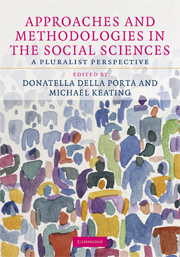Book contents
- Frontmatter
- Contents
- List of figures
- List of tables
- Contributors
- Preface
- 1 Introduction
- Part I Epistemology and philosophy of the social sciences
- Part II Research design
- 10 Concepts and concept formation
- 11 Comparative analysis: case-oriented versus variable-oriented research
- 12 Case studies and process tracing: theories and practices
- 13 Quantitative analysis
- 14 The design of social and political research
- 15 Ethnographic approaches
- 16 Comparing approaches, methodologies and methods. Some concluding remarks
- References
- Glossary
- Index
11 - Comparative analysis: case-oriented versus variable-oriented research
Published online by Cambridge University Press: 05 June 2012
- Frontmatter
- Contents
- List of figures
- List of tables
- Contributors
- Preface
- 1 Introduction
- Part I Epistemology and philosophy of the social sciences
- Part II Research design
- 10 Concepts and concept formation
- 11 Comparative analysis: case-oriented versus variable-oriented research
- 12 Case studies and process tracing: theories and practices
- 13 Quantitative analysis
- 14 The design of social and political research
- 15 Ethnographic approaches
- 16 Comparing approaches, methodologies and methods. Some concluding remarks
- References
- Glossary
- Index
Summary
Comparative analysis holds a central place in social science research. There is a well-established view in the social sciences that it should be based on variables (see Héritier, ch. 4, and Schmitter, ch. 14). Yet much research – especially in political science, but also in some branches of sociology – is case-oriented: that is, it aims at rich descriptions of a few instances of a certain phenomenon. This chapter argues that both approaches are legitimate. Variable-oriented studies mainly aim at establishing generalized relationships between variables, while case-oriented research seeks to understand complex units. Some people would argue that case-based comparisons follow a different logic of research, while others insist that the rules are essentially the same.
The chapter starts by introducing the debate on comparative analysis, distinguishing the experimental, statistical and ‘comparative’ methods. We then single out two main strategies of research, presenting their origins in the methodological reflections by Durkheim and Weber, and focusing on the assumptions that are linked to the variable-oriented and case-oriented approaches, respectively. Advantages and disadvantages of each will be discussed on the basis of illustrations from social science works on democratization, political violence and political participation, looking at examples of large-N statistical research designs and contrasting them with small-N comparisons, especially in the tradition of historical sociology. The chapter also discusses recent attempts to bridge the gap between the two approaches, in particular with qualitative comparative analysis (QCA) and recent reflections on the case-oriented strategy.
Information
- Type
- Chapter
- Information
- Approaches and Methodologies in the Social SciencesA Pluralist Perspective, pp. 198 - 222Publisher: Cambridge University PressPrint publication year: 2008
Accessibility standard: Unknown
Why this information is here
This section outlines the accessibility features of this content - including support for screen readers, full keyboard navigation and high-contrast display options. This may not be relevant for you.Accessibility Information
- 140
- Cited by
